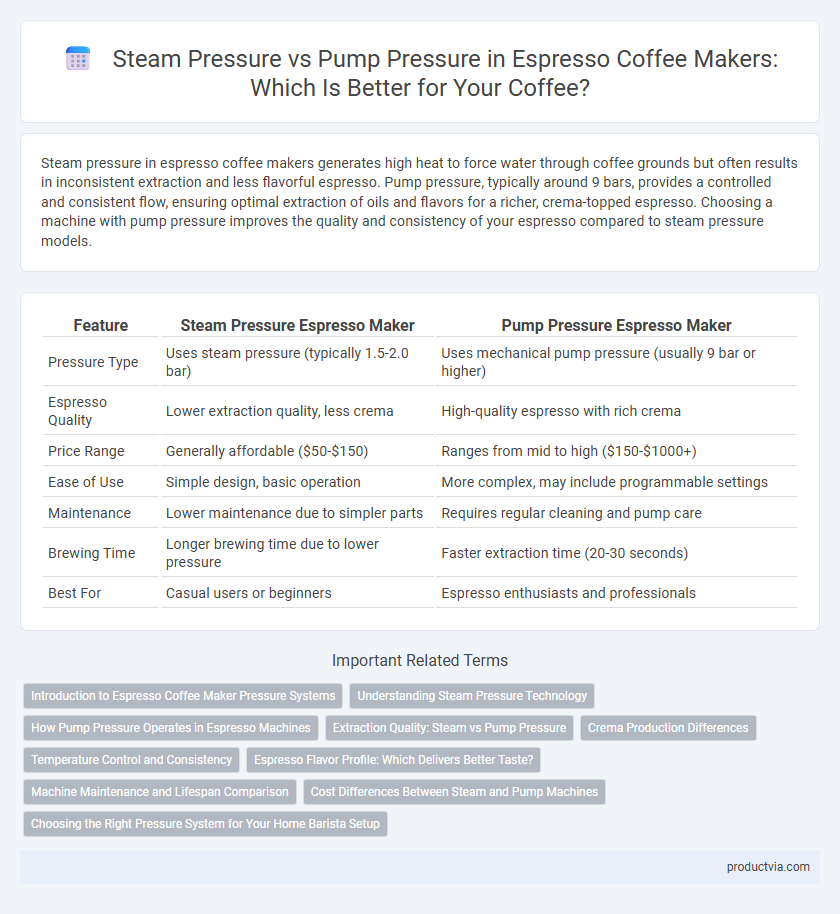Steam pressure in espresso coffee makers generates high heat to force water through coffee grounds but often results in inconsistent extraction and less flavorful espresso. Pump pressure, typically around 9 bars, provides a controlled and consistent flow, ensuring optimal extraction of oils and flavors for a richer, crema-topped espresso. Choosing a machine with pump pressure improves the quality and consistency of your espresso compared to steam pressure models.
Table of Comparison
| Feature | Steam Pressure Espresso Maker | Pump Pressure Espresso Maker |
|---|---|---|
| Pressure Type | Uses steam pressure (typically 1.5-2.0 bar) | Uses mechanical pump pressure (usually 9 bar or higher) |
| Espresso Quality | Lower extraction quality, less crema | High-quality espresso with rich crema |
| Price Range | Generally affordable ($50-$150) | Ranges from mid to high ($150-$1000+) |
| Ease of Use | Simple design, basic operation | More complex, may include programmable settings |
| Maintenance | Lower maintenance due to simpler parts | Requires regular cleaning and pump care |
| Brewing Time | Longer brewing time due to lower pressure | Faster extraction time (20-30 seconds) |
| Best For | Casual users or beginners | Espresso enthusiasts and professionals |
Introduction to Espresso Coffee Maker Pressure Systems
Espresso coffee makers function using two main pressure systems: steam pressure and pump pressure. Steam pressure machines rely on boiler-generated steam, typically exerting around 1.5 bar, producing less consistent pressure and flavor extraction. Pump pressure systems utilize electric pumps to deliver precise 9-bar pressure, enabling optimal espresso crema and rich taste, making them the preferred choice for quality espresso extraction.
Understanding Steam Pressure Technology
Steam pressure technology in espresso coffee makers uses high-temperature steam to extract coffee, typically generating pressure around 15 bars, which pushes water through the coffee grounds. This method creates rich crema but can sometimes result in uneven extraction due to fluctuating pressure levels. Compared to pump pressure machines, which provide consistent and controlled pressure, steam pressure machines are simpler and more affordable but may sacrifice precision in flavor extraction.
How Pump Pressure Operates in Espresso Machines
Pump pressure in espresso machines operates by forcing water through finely ground coffee at high pressure, typically around 9 bars, ensuring optimal extraction of flavors and crema. Unlike steam pressure, which relies on boiling water and creates inconsistent pressure, pump pressure provides precise water flow control critical for producing rich, balanced espresso. This mechanism uses an electric pump that maintains steady pressure throughout the brewing process, resulting in superior flavor and crema quality.
Extraction Quality: Steam vs Pump Pressure
Pump pressure espresso machines consistently deliver more precise extraction quality by maintaining stable pressure around 9 bars, which optimizes flavor and crema production. Steam pressure machines operate at higher, less controlled pressures (above 15 bars), often causing uneven extraction and bitter or sour flavors. The controlled pump pressure ensures balanced water flow and temperature, resulting in richer, more consistent espresso shots.
Crema Production Differences
Steam pressure espresso makers generate around 1.0 to 1.5 bars, producing less consistent crema with lower density and thinner texture. Pump pressure espresso machines operate at a standard 9 bars, delivering a rich, thick crema due to precise extraction and optimal pressure stability. The higher and regulated pump pressure ensures maximum emulsification of coffee oils, resulting in superior crema quality compared to steam pressure models.
Temperature Control and Consistency
Pump pressure espresso makers provide precise and consistent pressure, ensuring optimal temperature control throughout the extraction process, which is crucial for balanced flavor and aroma. Steam pressure machines often struggle with maintaining stable temperature, leading to fluctuations that can cause uneven extraction and bitterness. Consistency in pressure and temperature from pump systems results in a more reliable, high-quality espresso shot every time.
Espresso Flavor Profile: Which Delivers Better Taste?
Pump pressure espresso makers consistently deliver higher pressure, typically around 9 bars, resulting in a richer extraction that enhances the espresso's flavor complexity and crema quality. Steam pressure machines generate lower, less consistent pressure, often below 2 bars, which can lead to weaker, less balanced flavors with a more acidic or bitter profile. The optimal espresso flavor profile is achieved with pump pressure systems, ensuring a smoother, fuller-bodied taste prized by coffee connoisseurs.
Machine Maintenance and Lifespan Comparison
Steam pressure espresso machines generate pressure using heated steam, which often results in inconsistent extraction and increased wear on boiler components, requiring more frequent descaling and maintenance. Pump pressure machines maintain stable, high-pressure water flow (typically 9 bars), promoting consistent espresso quality and reduced strain on internal parts, leading to longer machine lifespan and less frequent servicing. Regular maintenance of pump pressure systems is generally simpler and more cost-effective, making them more durable and reliable over time compared to steam pressure models.
Cost Differences Between Steam and Pump Machines
Steam espresso machines typically have lower upfront costs, ranging from $100 to $300, due to their simpler design and use of boiler-generated steam pressure, which often results in less consistent extraction. Pump espresso machines, with prices commonly starting at $300 and reaching beyond $2,000 for high-end models, utilize an electric pump to deliver precise pressure, ensuring better espresso quality but at a higher cost. The durability and advanced technology of pump machines justify their higher price with improved performance and reliability in producing authentic espresso shots.
Choosing the Right Pressure System for Your Home Barista Setup
Steam pressure espresso machines typically operate at 1.0 to 1.5 bars, offering simplicity and affordability but producing less consistent extraction. Pump pressure systems, ranging from 9 to 15 bars, provide precise, stable pressure crucial for authentic espresso crema and flavor balance. Selecting a pump pressure machine enhances control and quality, making it the preferred choice for serious home baristas seeking professional-grade espresso.
Steam pressure vs Pump pressure for espresso coffee makers Infographic

 productvia.com
productvia.com